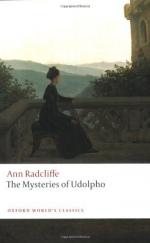|
This section contains 10,064 words (approx. 34 pages at 300 words per page) |

|
SOURCE: “Ann Radcliffe's Gothic Narrative and the Readers at Home,” in Studies in the Novel, Vol. 31, No. 4, Winter, 1999, pp. 409-31.
In the following essay, MacKenzie discusses Radcliffe's Gothic style and its effects on the eighteenth-century public mind.
Many trips to Scotland are undoubtedly projected and executed, and many unfortunate connections formed, from the influence which novels gain over the mind.
—Catherine MacAulay, Letters on Education
I. the Scene of Reading
During much the same period that the French Revolution horrified the public imagination of England, the Gothic novels of Ann Radcliffe terrified English private imaginations. As Edmund Burke and others fought Jacobin sentiments (and lack of sentiment) in the political theater, Radcliffe claimed an altogether easier conquest of the hearth. Her novels are Gothic—really the apogee of the form's early ascendancy—but they are also domestic; home is ever-present, ever-discussed, ever-sought. Home is also the cover to...
|
This section contains 10,064 words (approx. 34 pages at 300 words per page) |

|


